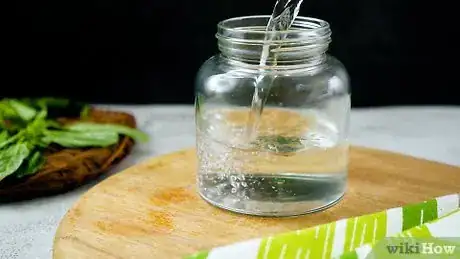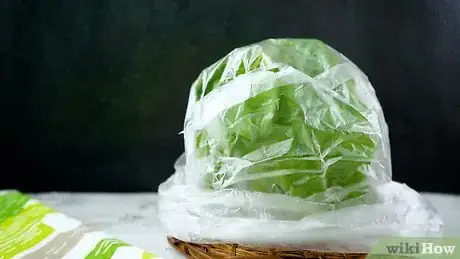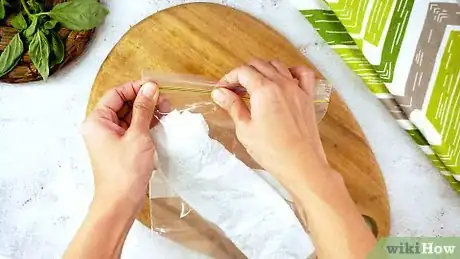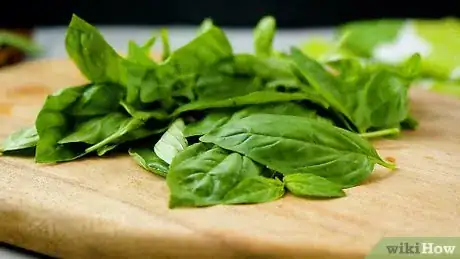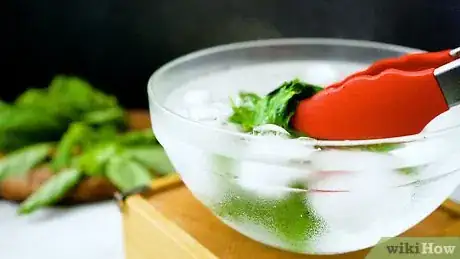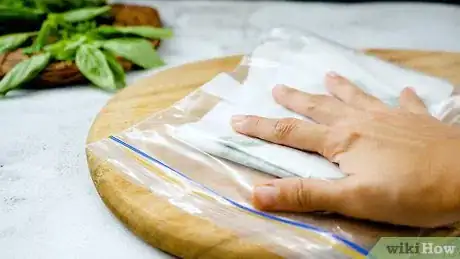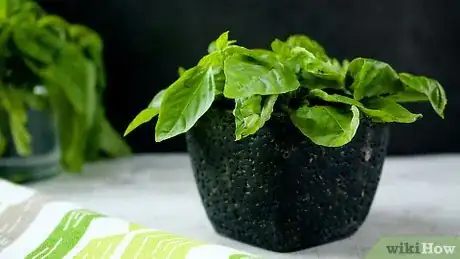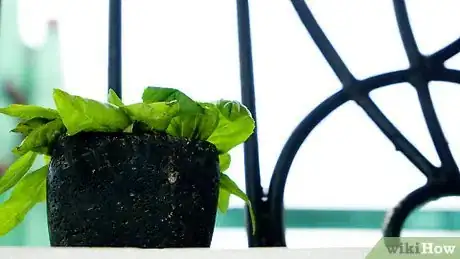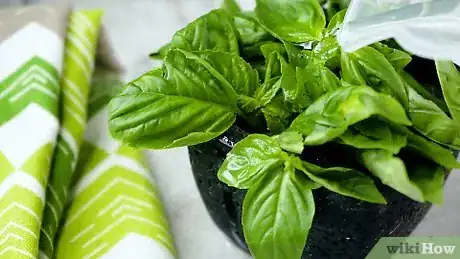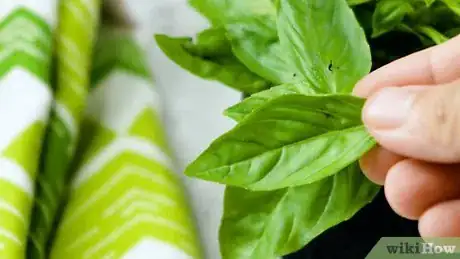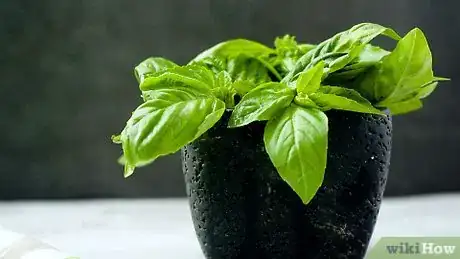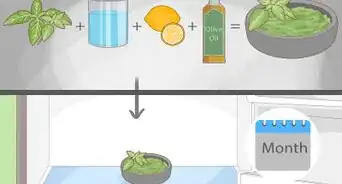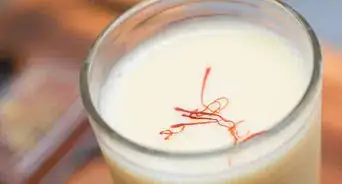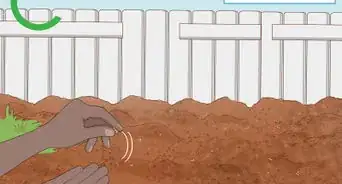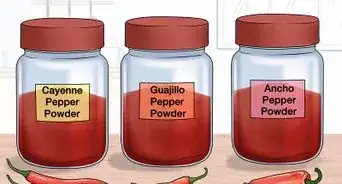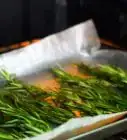This article was co-authored by Ollie George Cigliano and by wikiHow staff writer, Christopher M. Osborne, PhD. Ollie George Cigliano is a Private Chef, Food Educator, and Owner of Ollie George Cooks, based in Long Beach, California. With over 20 years of experience, she specializes in utilizing fresh, fun ingredients and mixing traditional and innovative cooking techniques. Ollie George holds a BA in Comparative Literature from The University of California, Berkeley, and a Nutrition and Healthy Living Certificate from eCornell University.
wikiHow marks an article as reader-approved once it receives enough positive feedback. This article received 13 testimonials and 100% of readers who voted found it helpful, earning it our reader-approved status.
This article has been viewed 650,635 times.
Whether you’ve just harvested homegrown basil or bought a bunch of basil at the supermarket, you have several fresh storage options. You can put it in water like a bouquet of flowers, or store the leaves in the fridge like lettuce for a very short time. Blanching and freezing the leaves can preserve the fresh flavor for several months. Or, just keep a small pot of basil on the windowsill so you can go straight from harvesting it to using it!
Steps
Storing a “Bouquet” of Basil
-
1Fill a small vase or tall jar about halfway with water. A clean flower vase or any tall, wide-mouth jar will do. Tap water should work just fine, but some herb lovers contend that bottled water yields better results.[1]
- Don’t use distilled water, as it lacks beneficial minerals that may help preserve the basil longer.
-
2Trim the bottom 1 in (2.5 cm) off the basil stems. If you just snipped the stems fresh from your garden, don’t worry about doing this. If you bought a bunch of basil at the supermarket, though, cutting the bottom of each stem will keep the basil fresh longer.[2]
- Also pluck off any leaves that are low on the stems and will be submerged in the water.
Advertisement -
3Put the basil in the jar and store it at around 65 °F (18 °C). Make sure the tips of all the stems are submerged. Pick a storage location that doesn’t get direct sunlight and tends to be at the cooler end of room temperature. For instance, the corner of your kitchen countertop or a shelf on an open pantry might work.[3]
- Don’t put the vase in the refrigerator or anywhere else that gets below 50 °F (10 °C). This is a good idea for many other herbs, but basil leaves keep better in water on the counter than in the fridge.
-
4Place a produce bag loosely over the basil bouquet, if desired. The bag cuts down on the visual appeal of a bouquet of vibrant basil on your countertop, but it may help the basil keep longer. Run a test with and without a bag to determine which method works best for you.[4]
- Don’t cinch up the bag around the vase. It’s important to allow for air flow.
- Thin plastic bags, like those found in the produce section of the grocery store, are ideal for this task.
-
5Change the water every 1-2 days to get up to 7 days of usable basil. Replace the water whenever it gets cloudy, if the level drops by 0.5 in (1.3 cm), or at least every other day. With luck, you’ll have a week’s worth of vibrant basil leaves that are pretty enough to use on top of a Caprese salad![5]
- Remember to rinse the leaves under clean, cool water before using them in recipes.
- The leaves will start to wilt after around 5-8 days, but they still may be usable in a cooked item like marinara sauce.
Stashing Leaves in the Fridge
-
1Pluck off the leaves and rinse them under cool water. Discard any leaves that are already wilted or that have brown or black spots. Either rinse each leaf individually or put them in a colander for rinsing.[6]
- This method is basically the same as one used for storing lettuce. However, don’t expect basil to last nearly as long in the fridge as lettuce or most other greens.
-
2Pat the leaves dry gently with paper towels. Lay out the rinsed leaves on a single layer of paper towels, then use more paper towels to blot them dry. Remove as much surface moisture as you can without bruising the leaves.[7]
- Alternatively, you can use a salad spinner to dry the leaves.
-
3Wrap the leaves loosely in dry paper towels. Unroll enough connected sheets of paper towel so that you can lay out the leaves in a single layer. Once the leaves are in place, loosely roll up the paper towel strip.[8]
- Don’t roll the paper towel strip tightly or press down on it as you go. You’ll bruise the leaves.
- Wrapping the leaves in paper towels helps to regulate the moisture content and keep the basil from getting either too dry or too moist.
-
4Seal the basil in a zip-close bag and put it in the fridge. Slide the rolled-up basil into a 1 US gal (3.8 L) or larger zip-close bag, then gently press out most of the air. Zip up the bag so it’s about 90% sealed—leaving a small section unzipped for air circulation—and put it in the fridge in a spot where it won’t get scrunched or squashed.[9]
- Long-term refrigerator storage isn’t an option for basil, so stick it in a spot where you can access it easily.
-
5Use the basil within 12 (maybe 24) hours for the best results. Chilled basil leaves start to develop brown or black spots within hours. They’ll also start to wilt within a day and may already be unusable after only 24 hours.[10]
- Use this only as a short-term prep and storage option—for instance, if you bought fresh basil at the store in the morning to put on top of your homemade pizza for dinner.
Freezing Fresh Basil Leaves
-
1Prepare a pot of boiling water and an ice bath. Put a large pot of water on the stove and set the burner to high heat. As the water heats, add the contents of about 2 ice cube trays to a large bowl, then fill the bowl about 75% full of cold water.[11]
- This method of blanching and then freezing the basil is a good option when you have far more fresh basil than you can use within a few days—for example, if an early fall frost is about to hit and you still have plenty of basil in your herb garden.
-
2Blanch the plucked and rinsed leaves for 2 seconds. As the pot of water nears a boil, pluck the basil leaves from their stems and rinse them under cool water. When the pot finally comes to a boil, toss all the leaves in at once for just 2 seconds.[12]
- Don't use basil leaves that are drooping or blackened.
-
3Move the blanched leaves immediately to an ice bath. After the quick 2-second blanching, use tongs to pull out the leaves as quickly as you can. Transfer them straight to the ice bath.[13]
- Blanching helps “lock in” the vibrant color of the basil leaves, while the ice bath stops the cooking process before it wilts the leaves.
- If you wish, you can skip both blanching the leaves and using an ice bath, but the basil won’t keep as well in the freezer. In this case, go straight from rinsing the fresh leaves to drying them with paper towels.
-
4Move the cooled leaves from the ice bath to paper towels for drying. After about 1-2 minutes in the ice bath, use your fingers to transfer the leaves to a strip of paper towels. Lay out the leaves in a single layer and softly blot away all surface moisture with more paper towels.[14]
- Or, invest in a salad spinner that you can use to dry basil leaves—among many other things!
-
5Lay a single layer of leaves on a sheet of wax paper, then repeat. Rip a sheet of wax paper that will fit easily into a large zip-close freezer bag. Lay out the basil leaves on the sheet, nestling them close together but not overlapping them. Cover the basil leaves with another sheet of wax paper, add another layer of leaves, and keep going until you’re out of basil leaves.[15]
- If you go above about 4-5 layers of basil leaves, you may not be able to slide the stack into a freezer bag. In this case, start a second stack for another freezer bag.
-
6Slide the layered leaves into a freezer bag to store for up to 6 months. Carefully work the stack of wax paper and basil leaves into the zip-close bag, then gently press out most of the air. Zip the bag fully closed and write “basil” and today’s date on the bag with a permanent marker. Lay the bag flat in the freezer in a spot where it won’t get crushed.[16]
- When you’re ready to use the basil, simply open the bag, pull out the number of leaves you need, squeeze out the air, and close the bag again.
- Especially if blanched, frozen basil leaves should be vibrant and flavorful enough to use in cooked recipes or even fresh pesto. The thawed leaves will likely be too wilted to use as a fresh ingredient or garnish, however.
- After about 3-6 months, the leaves will start to develop brown or black spots. Once there are as many dark spots as green areas, discard the leaves.
Keeping Potted Basil Indoors
-
1Buy a small potted basil from your grocer’s produce department. The easiest way to keep basil fresh is to keep it alive! Instead of buying a cut bunch of basil at the supermarket, check to see if they also sell small potted basil plants. These usually come in biodegradable “pots” and are typically sold right next to the fresh cut herbs.[17]
-
2Set the pot on a windowsill that gets ample sunlight. Ideally, basil should get 6-8 hours of sunlight per day. If that’s not possible where you live, pick the sunniest windowsill you have.[18]
- It’s very convenient to have the basil plant on your kitchen windowsill, but it’s more important to find a sunny spot.
-
3Keep the potting medium evenly moist with regular watering. Stick your index finger 1 in (2.5 cm) down into the potting medium every 1-2 days. If it feels dry at your fingertip, add water until the potting medium looks soaked but not oversaturated.[19]
- The goal is to keep the potting medium evenly moist. You’ll likely figure out the proper watering frequency within a week.
-
4Pluck off fresh leaves right when you need them. This is the best part about having fresh, live basil right at your fingertips. Identify the most colorful, crisp-tender leaves and pluck just the number you need at that moment.[20]
- For instance, grab a few of the prettiest leaves to make your guests a range of delicious basil cocktails![21]
- Remove and discard leaves that have wilted or developed brown or black spots.
-
5Replace it with a new potted basil every several weeks, as needed. Kept in its original compostable pot, the supermarket basil plant will likely give you 1-2 months of high-quality basil leaves. Once it stops producing abundantly, go ahead and get a replacement from the grocery store.[22]
- The basil will likely last longer if you transfer it to a larger pot, but it may also grow larger than you’d prefer, especially if you have space limitations.
Community Q&A
-
QuestionCan you use the top growth of basil with the flower on it?
 Community AnswerUse it as a dried herb. If you water your plant more, and you will get less flowers and more leaf. Basil loves and thrives with a constant moist soil, and 6-8 hours of direct sun.
Community AnswerUse it as a dried herb. If you water your plant more, and you will get less flowers and more leaf. Basil loves and thrives with a constant moist soil, and 6-8 hours of direct sun. -
QuestionIs it possible to over-water basil?
 Community AnswerNot really, because you can literally grow basil in water with no soil.
Community AnswerNot really, because you can literally grow basil in water with no soil. -
QuestionHow do I refrigerate basil?
 Community AnswerThe best way for basil to retain freshness in the refrigerator is to wrap it in moist paper towels and place it in a plastic container.
Community AnswerThe best way for basil to retain freshness in the refrigerator is to wrap it in moist paper towels and place it in a plastic container.
Things You'll Need
Storing a “Bouquet” of Basil
- Vase or tall jar
- Garden or kitchen scissors
- Plastic produce bag (optional)
Stashing Leaves in the Fridge
- Paper towels
- Large zip-close bag
Freezing Fresh Basil Leaves
- Large pot
- Large bowl
- Tongs
- Paper towels
- Wax paper
- Large freezer bag
Keeping Potted Basil Indoors
- Small potted basil plant
References
- ↑ https://www.thekitchn.com/the-best-way-to-store-basil-192880
- ↑ http://www.eatingwell.com/article/290681/the-best-way-to-store-fresh-basil/
- ↑ https://www.thekitchn.com/the-best-way-to-store-basil-192880
- ↑ http://www.eatingwell.com/article/290681/the-best-way-to-store-fresh-basil/
- ↑ https://www.thekitchn.com/the-best-way-to-store-basil-192880
- ↑ https://food52.com/blog/22732-i-tested-basil-storage-methods
- ↑ https://food52.com/blog/22732-i-tested-basil-storage-methods
- ↑ https://food52.com/blog/22732-i-tested-basil-storage-methods
- ↑ https://food52.com/blog/22732-i-tested-basil-storage-methods
- ↑ https://food52.com/blog/22732-i-tested-basil-storage-methods
- ↑ https://www.thekitchn.com/3-tips-for-preserving-fresh-basil-all-year-long-tips-from-the-kitchn-207032
- ↑ https://www.thekitchn.com/3-tips-for-preserving-fresh-basil-all-year-long-tips-from-the-kitchn-207032
- ↑ https://www.thekitchn.com/3-tips-for-preserving-fresh-basil-all-year-long-tips-from-the-kitchn-207032
- ↑ https://www.thekitchn.com/3-tips-for-preserving-fresh-basil-all-year-long-tips-from-the-kitchn-207032
- ↑ https://www.thekitchn.com/3-tips-for-preserving-fresh-basil-all-year-long-tips-from-the-kitchn-207032
- ↑ https://www.thekitchn.com/3-tips-for-preserving-fresh-basil-all-year-long-tips-from-the-kitchn-207032
- ↑ http://www.eatingwell.com/article/290681/the-best-way-to-store-fresh-basil/
- ↑ http://www.eatingwell.com/article/290681/the-best-way-to-store-fresh-basil/
- ↑ http://www.eatingwell.com/article/290681/the-best-way-to-store-fresh-basil/
- ↑ http://www.eatingwell.com/article/290681/the-best-way-to-store-fresh-basil/
- ↑ https://drinks.seriouseats.com/2013/07/fresh-basil-cocktails-for-summer-easy-drink-recipes.html
- ↑ http://www.eatingwell.com/article/290681/the-best-way-to-store-fresh-basil/
About This Article
To store fresh basil that you plan on cooking with soon, just rest it in a glass of water so the stems are submerged and set it somewhere away from direct sunlight. If you want to store fresh basil for longer, start by pulling all of the leaves off the stems. Then, dry the leaves completely and spread them out on a baking sheet or tray. Freeze the leaves for several hours and then transfer them to a freezer bag, which will help prevent them from sticking together. When you're ready to use your basil, just take it out of the freezer and add it to your recipe!
